Wordless picture books are one of the best ways to invite readers to actively participate in a story. Examining these books present great challenges to both readers and authors/illustrators as they no longer rely on words. While some teachers find wordless picture books useful for fostering young children’s literacy skills and imagination, picture books without text also provide reading pleasure for older readers. This week’s book reviews from members of the Children’s Literature and Reading Special Interest Group invites readers of all ages to experience the power of illustrations and the surprises and delights that these picture books carry to revive or strengthen our love for reading.
Becker, Aaron. (2014). Quest. Somerville, MA: Candlewick.
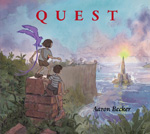 In this sequel to Journey (2013), a 2014 Caldecott Honor Book, author/illustrator Aaron Becker takes readers on another adventure with the previous book’s characters, a young girl and the young boy she has just met. Carrying red and purple chalks as well as accompanied by a magical purple bird, they meet an old king in an orange robe. He shows them a map with several colorful circles on it. While the king is trying to explain the map to the boy and the girl, two soldiers appear suddenly and arrest him but not before he leaves them an orange chalk, which sets them off on a quest to save the king. By following the map, they travel to different places, from under the sea and a desolate castle to a landmark on snowcapped mountains. Chased by a group of soldiers, they are able to complete their quest and save the king with their wits and bravery and the help of the magical bird. Readers will experience the power of wonder and the value of companionship through this picture book. With watercolor, pen, and ink illustrations adding a tone of mystery to the quest, this story invites readers to continue the imaginative journey begun in Becker’s earlier title.
In this sequel to Journey (2013), a 2014 Caldecott Honor Book, author/illustrator Aaron Becker takes readers on another adventure with the previous book’s characters, a young girl and the young boy she has just met. Carrying red and purple chalks as well as accompanied by a magical purple bird, they meet an old king in an orange robe. He shows them a map with several colorful circles on it. While the king is trying to explain the map to the boy and the girl, two soldiers appear suddenly and arrest him but not before he leaves them an orange chalk, which sets them off on a quest to save the king. By following the map, they travel to different places, from under the sea and a desolate castle to a landmark on snowcapped mountains. Chased by a group of soldiers, they are able to complete their quest and save the king with their wits and bravery and the help of the magical bird. Readers will experience the power of wonder and the value of companionship through this picture book. With watercolor, pen, and ink illustrations adding a tone of mystery to the quest, this story invites readers to continue the imaginative journey begun in Becker’s earlier title.
—Ying-Hsuan Lee, Washington State University Pullman
Boyd, Lizi. (2014). Flashlight. San Francisco, CA: Chronicle Books.
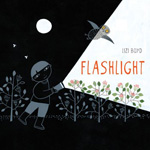 When night falls, the dark does not mean that nature becomes silent. Carrying a flashlight, a curious boy walks out of his cozy tent to explore the woods at night. It turns out the excursion into the woods after dark is quite interesting. He discovers his lost boot on the grass. Bats fly through the air. An owl perches on the tree. Mice and skunks walk freely. Beavers are constructing a river house. Fish, frogs, foxes, deer, and butterflies all leisurely take their time moving about. Sitting by a tree and having a snack and a rest are luxuries that come from night exploration. Oops! The boy tumbles over a rock, losing his flashlight. To his relief, a raccoon picks it up, and all the animal friends the boy encounters during the exploration help him return to his cozy tent. This picture book invites readers to see nature’s nocturnal beauty through several cut-outs accentuating details on the illustrations. Moreover, the illustrations, rendered in gouache, capture the serene but lively night. Readers may be inspired to take their own night trip outside to appreciate nature in the dark.
When night falls, the dark does not mean that nature becomes silent. Carrying a flashlight, a curious boy walks out of his cozy tent to explore the woods at night. It turns out the excursion into the woods after dark is quite interesting. He discovers his lost boot on the grass. Bats fly through the air. An owl perches on the tree. Mice and skunks walk freely. Beavers are constructing a river house. Fish, frogs, foxes, deer, and butterflies all leisurely take their time moving about. Sitting by a tree and having a snack and a rest are luxuries that come from night exploration. Oops! The boy tumbles over a rock, losing his flashlight. To his relief, a raccoon picks it up, and all the animal friends the boy encounters during the exploration help him return to his cozy tent. This picture book invites readers to see nature’s nocturnal beauty through several cut-outs accentuating details on the illustrations. Moreover, the illustrations, rendered in gouache, capture the serene but lively night. Readers may be inspired to take their own night trip outside to appreciate nature in the dark.
—Ying-Hsuan Lee, Washington State University Pullman
Colón, Raúl. (2014). Draw! New York, NY: Simon & Schuster Books for Young Readers.
 What might happen to a boy with pencils, sketchbooks, and a book about Africa in hand? After reading about Africa, the boy, stretching his imagination, carries his pencils and sketchbooks and enters his own African safari where he draws elephants, zebras, giraffes, lions, chimpanzees, and rhinoceroses. Of course, he makes friends with some animals and is chased by others. This is such a wonderful adventure that the boy is excited to show all his lively drawings of African animals to his classmates. While the story allows readers to let their imagination run wild, the illustrations, rendered in pen and ink, watercolors, colored pencils, and lithograph pencils, with a yellowish and orange hue, make the African safari look real. As one of The New York Times Best Illustrated Books for 2014, Raúl Colón, based on his own childhood experiences, invites readers to experience the power of imagination and drawing.
What might happen to a boy with pencils, sketchbooks, and a book about Africa in hand? After reading about Africa, the boy, stretching his imagination, carries his pencils and sketchbooks and enters his own African safari where he draws elephants, zebras, giraffes, lions, chimpanzees, and rhinoceroses. Of course, he makes friends with some animals and is chased by others. This is such a wonderful adventure that the boy is excited to show all his lively drawings of African animals to his classmates. While the story allows readers to let their imagination run wild, the illustrations, rendered in pen and ink, watercolors, colored pencils, and lithograph pencils, with a yellowish and orange hue, make the African safari look real. As one of The New York Times Best Illustrated Books for 2014, Raúl Colón, based on his own childhood experiences, invites readers to experience the power of imagination and drawing.
—Ying-Hsuan Lee, Washington State University Pullman
Frazee, Marla. (2014). The Farmer and the Clown. New York, NY: Beach Lane Books/ Simon & Schuster
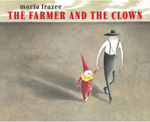 While a hard-working farmer is taking a rest, a toot-toot train happens to run by. To his surprise, a baby clown bounces off the train and walks to him. With considerable sympathy, the farmer takes the baby clown to his farmhouse, and they live together. They have meals together, they entertain each other. Their companionship adds some fun while they work on the farm. One day as they go on a picnic, the toot-toot train passes again. The farmer and the baby clown run as fast as they can to catch up with the train so the baby clown can finally reunite with the clown family. As they bid farewell to the farmer and leave on the train, a clown monkey secretly follows the farmer home. Through the characters’ facial expressions and body movements, this wordless picture book presents a heartwarming story featuring many happy moments shared between the farmer and the baby clown. The illustrations, created with colored pencil and gouache, have a nostalgic tone, which may remind readers of their own pleasant memories of visiting a circus or carnival.
While a hard-working farmer is taking a rest, a toot-toot train happens to run by. To his surprise, a baby clown bounces off the train and walks to him. With considerable sympathy, the farmer takes the baby clown to his farmhouse, and they live together. They have meals together, they entertain each other. Their companionship adds some fun while they work on the farm. One day as they go on a picnic, the toot-toot train passes again. The farmer and the baby clown run as fast as they can to catch up with the train so the baby clown can finally reunite with the clown family. As they bid farewell to the farmer and leave on the train, a clown monkey secretly follows the farmer home. Through the characters’ facial expressions and body movements, this wordless picture book presents a heartwarming story featuring many happy moments shared between the farmer and the baby clown. The illustrations, created with colored pencil and gouache, have a nostalgic tone, which may remind readers of their own pleasant memories of visiting a circus or carnival.
—Ying-Hsuan Lee, Washington State University Pullman
Hoogstad, Alice. (2014). Monster Book. New York, NY: Lemniscaat USA, LLC.
 A little girl who lives in a black and white town is the only one who owns colorful magic chalks. She loves to draw, and whatever she draws seems to come to life. She first draws a red heart-shaped balloon that is carried by a dog, and then many colorful cartoonish monsters are animated out of her creativity. At first, the town people are surprised to see so many colorful creatures beautify their monotonous town. However, as some monsters join the girl to add colors to town buildings and even draw on people’s faces, the town’s citizens call a police officer to ask the girl to wash the color away. A storm comes with heavy rain when the girl cleans up the mess. While the adults are happy to have their drab town restored, a group of children joins the girl to resume coloring secretly on the other side of the town. With illustrations created with pen and crayons are presented in a childlike style, this book will resonate with readers who have been fallen in love with coloring and drawing.
A little girl who lives in a black and white town is the only one who owns colorful magic chalks. She loves to draw, and whatever she draws seems to come to life. She first draws a red heart-shaped balloon that is carried by a dog, and then many colorful cartoonish monsters are animated out of her creativity. At first, the town people are surprised to see so many colorful creatures beautify their monotonous town. However, as some monsters join the girl to add colors to town buildings and even draw on people’s faces, the town’s citizens call a police officer to ask the girl to wash the color away. A storm comes with heavy rain when the girl cleans up the mess. While the adults are happy to have their drab town restored, a group of children joins the girl to resume coloring secretly on the other side of the town. With illustrations created with pen and crayons are presented in a childlike style, this book will resonate with readers who have been fallen in love with coloring and drawing.
—Ying-Hsuan Lee, Washington State University Pullman
Idle, Molly. (2014). Flora and the Penguin. San Francisco, CA: Chronicle Books.
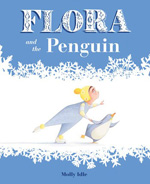 Author/illustrator Molly Idle returns to the character from her 2014 Caldecott Honor winner, Flora and the Flamingo, only this time with Flora has a new friend, Penguin. Tightening up her ice skating shoes, Flora is ready to glide, spin, leap, and twirl on the ice with Penguin. However, the new partners have some points of disagreement, and the penguin, attracted by fish under the ice, disappears for a while. When the penguin shows up again the pair finds way to skate together and the duo glide on the ice beautifully and gracefully again. This wordless picture book with simple illustrations capturing subtle details and emotions traces perfectly the ups and downs in the story of friendship between Flora and Penguin. With lift-up paper on several pages, readers can exercise their imagination to fill in the wordless text and make sense of the plot. Although the illustrations rely only on yellow, blue and white colors, the book’s visual simplicity does not detract from the pleasure of reading. Readers will surely enjoy the lively and lovely performance of Flora and Penguin.
Author/illustrator Molly Idle returns to the character from her 2014 Caldecott Honor winner, Flora and the Flamingo, only this time with Flora has a new friend, Penguin. Tightening up her ice skating shoes, Flora is ready to glide, spin, leap, and twirl on the ice with Penguin. However, the new partners have some points of disagreement, and the penguin, attracted by fish under the ice, disappears for a while. When the penguin shows up again the pair finds way to skate together and the duo glide on the ice beautifully and gracefully again. This wordless picture book with simple illustrations capturing subtle details and emotions traces perfectly the ups and downs in the story of friendship between Flora and Penguin. With lift-up paper on several pages, readers can exercise their imagination to fill in the wordless text and make sense of the plot. Although the illustrations rely only on yellow, blue and white colors, the book’s visual simplicity does not detract from the pleasure of reading. Readers will surely enjoy the lively and lovely performance of Flora and Penguin.
—Ying-Hsuan Lee, Washington State University Pullman
Jay, Alison. (2014). Out of the Blue. Cambridge, MA: Barefoot Books.
 In a lighthouse by the sea lives a young boy with his father and dog. On a sunny day the boy and his dog go outside to play at the beach where he meets a young girl. The new friends have a blast picking up shells, catching and releasing fish, and watching the immense whales bathing in the sea. Suddenly, a thunderstorm comes with lightning and heavy rain that causes the sea to undulate violently. After a night of restlessness, the sea calms, and people return to the beach to enjoy the sunshine. However, a huge octopus is stranded on the beach, which scares everyone, and the boy is the only one who sympathizes with it, even deciding to cut the net and set the squid free. This wordless picture book is ideal for teaching life science and marine preservation. Several pages at the end of the book provide information about marine life and lighthouses. The illustrations, rendered in oil paint with a crackling varnish, use frames, borders, and various points of view to guide readers throughout the story. This book can trigger readers’ interests in exploring the sea and its fascinating creatures.
In a lighthouse by the sea lives a young boy with his father and dog. On a sunny day the boy and his dog go outside to play at the beach where he meets a young girl. The new friends have a blast picking up shells, catching and releasing fish, and watching the immense whales bathing in the sea. Suddenly, a thunderstorm comes with lightning and heavy rain that causes the sea to undulate violently. After a night of restlessness, the sea calms, and people return to the beach to enjoy the sunshine. However, a huge octopus is stranded on the beach, which scares everyone, and the boy is the only one who sympathizes with it, even deciding to cut the net and set the squid free. This wordless picture book is ideal for teaching life science and marine preservation. Several pages at the end of the book provide information about marine life and lighthouses. The illustrations, rendered in oil paint with a crackling varnish, use frames, borders, and various points of view to guide readers throughout the story. This book can trigger readers’ interests in exploring the sea and its fascinating creatures.
—Ying-Hsuan Lee, Washington State University Pullman
Merveille, David. (2013). Hello, Mr. Hulot. New York, NY: North South Books Inc.
 This book portrays a famous French character, Mr. Hulot, played by comic actor Jacques Tati during 1950s and 1960s. Mr. Hulot is well-known for his fun and abnormal personality that enables him to see the world from a different perspective. The 23 scenes included in the book present visual humor and surprising outcomes that may make readers laugh out loud. For example, the shadow of Mr. Hulot is pictured as Don Quixote, and Mr. Hulot’s shaking of a snow globe results in snow falling on a summer day. The comic strip-style illustrations add visual interest to the book and readers will surely enjoy reading and rereading.
This book portrays a famous French character, Mr. Hulot, played by comic actor Jacques Tati during 1950s and 1960s. Mr. Hulot is well-known for his fun and abnormal personality that enables him to see the world from a different perspective. The 23 scenes included in the book present visual humor and surprising outcomes that may make readers laugh out loud. For example, the shadow of Mr. Hulot is pictured as Don Quixote, and Mr. Hulot’s shaking of a snow globe results in snow falling on a summer day. The comic strip-style illustrations add visual interest to the book and readers will surely enjoy reading and rereading.
—Ying-Hsuan Lee, Washington State University Pullman
Pett, Mark. (2014). The Girl and the Bicycle. New York, NY: Simon & Schuster Books for Young Readers.
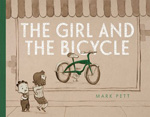 Passing by a store with her brother, a girl spies a shiny green bicycle in the store window. Her desire to own the bicycle makes her work hard to save money. She sells lemonade and her used toys, she offers to help neighbors with their yard work. However, no one stops at her lemonade stall and toy stand, and all of the neighbors, except one woman, turn her down. As the girl works for the woman, their friendship grows. After a year’s hard work and saving, the girl finally has enough money to buy the bicycle. When she takes her money and rushes to the store excitedly, she finds that the bicycle is gone. Disappointed, she instead uses her money to buy a bicycle for her brother. On her way home, the woman invites the girl to her house. To her surprise, the woman has bought the shiny green bicycle she wanted so much as a present. The use of pencil and watercolor for the illustrations creates a retro tone with a down-to-earth yet warm feel. The book shows the importance of saving money, working hard, and delaying gratification, as well as the value of kindness and generosity. Hard work does not go unrewarded as this book shows so perfectly.
Passing by a store with her brother, a girl spies a shiny green bicycle in the store window. Her desire to own the bicycle makes her work hard to save money. She sells lemonade and her used toys, she offers to help neighbors with their yard work. However, no one stops at her lemonade stall and toy stand, and all of the neighbors, except one woman, turn her down. As the girl works for the woman, their friendship grows. After a year’s hard work and saving, the girl finally has enough money to buy the bicycle. When she takes her money and rushes to the store excitedly, she finds that the bicycle is gone. Disappointed, she instead uses her money to buy a bicycle for her brother. On her way home, the woman invites the girl to her house. To her surprise, the woman has bought the shiny green bicycle she wanted so much as a present. The use of pencil and watercolor for the illustrations creates a retro tone with a down-to-earth yet warm feel. The book shows the importance of saving money, working hard, and delaying gratification, as well as the value of kindness and generosity. Hard work does not go unrewarded as this book shows so perfectly.
—Ying-Hsuan Lee, Washington State University Pullman
These reviews are submitted by members of the International Reading Association's Children's Literature and Reading Special Interest Group (CL/R SIG) and are published weekly on Reading Today Online.